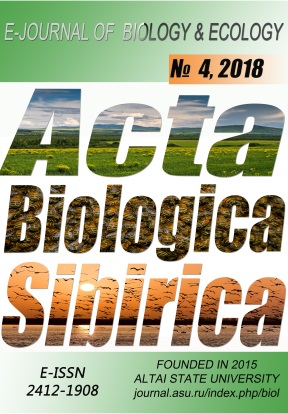Аннотация
Algal-bacterial associations were studied in unialgal xenic cultures of Synedra acus subsp. radians, Asterionella formosa and Fragillaria crotonensis planktonic diatoms from Lake Baikal, using epifluorescent and scanning electron microscopy. It was found that rod- and ovoid-shaped bacteria colonized cell walls of diatoms. Cloning and sequencing of fragments of 16S rRNA gene in diatom cultures revealed members of Gammaproteobacteria (Pseudomonas sp.), Betaproteobacteria (Janthinobacterium sp., Hydrogenophaga sp., Methylophilus sp.), Bacteroidetes (Flavobacterium sp., Pedobacter sp.), and Acinobacteria (Nocardioides sp.).
Литература
Armbrust, E.V. (2009). The life of diatoms in the world’s oceans. Nature, 459, 185–192.
Azam, F., Malfatti, F. (2007). Microbial structuring of marine ecosystems. Nature Reviews Microbiology, 5, 782–791.
Bagatini, I.L., Eiler, A., Bertilsson, S., Klaveness, D., Tessarolli, L.P., Vieira, A.A.H. (2014). Host-specificity and dynamics in bacterial communities associated with bloom-forming freshwater phytoplankton. PloS ONE, 9(1), e85950.
Bruckner, C.G., Bahulikar, R., Rahalkar, M., Schink, B., Kroth, P. (2008). Bacteria associated with benthic diatoms from Lake Constance: phylogeny and influences on diatom growth and secretion of extracellular polymeric substances. Applied and Environmental Microbiology, 74(24), 7740–7749.
Buchan, A., LeCleir, G.R., Gulvik, C.A., González, J.M. (2014). Master recyclers: features and functions of bacteria associated with phytoplankton blooms. Nature Reviews Microbiology, 12, 686–698.
Cole, J.J. (1982). Interactions between bacteria and algae in aquatic ecosystems. Annual Review of Ecology and Systematics, 13, 291–314.
Croft, M.T., Lawrence, A.D., Raux-Deery, E., Warren, M.J., Smith, A.G. (2005). Algae acquire vitamin B12 through a symbiotic relationship with bacteria. Nature, 438, 90–93.
Denisova, L.Y., Bel’kova, N.L., Tulokhonov, I.I., Zaichikov, E.F. (1999). Bacterial diversity at various depths in the southern part of Lake Baikal as revealed by 16S rDNA sequencing. Microbiology, 68(4), 475–483.
Gärdes, A., Iversen, M.H., Grossart, H.P., Passow, U., Ulrich, M.S. (2011). Diatom-associated bacteria are required for aggregation of Thalassiosira weissflogii. The ISME Journal, 5, 436–445.
Grossart, H.-P., Levold, F., Allgaier, M., Simon, M., Brinkhoff, T. (2005). Marine diatom species harbour distinct bacterial communities. Environmental Microbiology, 7(6), 860–873.
Guannel, M.L., Horner-Devine, M.C., Rocap, G. (2011). Bacterial community composition differs with species and toxigenicity of the diatom Pseudo-nitzschia. Aquatic Microbial Ecology, 64, 117–133.
Inoue, H., Nojima, H., Okayama, H. (1990). High efficiency transformation of Escherichia coli with plasmids. Gene, 96(1), 23–28.
Marmur, J. (1961). A procedure for the isolation of deoxyribonucleic acid from micro-organisms. Journal of Molecular Biology, 3(2), 208–218.
Mikhailov, I.S., Zakharova, Y.R., Galachyants, Y.P., Usoltseva, M.V., Petrova, D.P., Sakirko, M.V., Likhoshway, E.V., Grachev, M.A. (2015). Similarity of structure of taxonomic bacterial communities in the photic layer of Lake Baikal’s three basins differing in spring phytoplankton composition and abundance. Doklady Biochemistry Biophysics, 465, 413–419.
Mila, K.S., Adrien, V., Carine, P., Sophie, F.S., Laura, P., Pierre, H., Gérald, G., Yizhi, Z., Jean‐François, S., Jean‐Michel, C., Guillaume, B. Brigitte, G. (2018). Exploring the microbiome of the “star” freshwater diatom Asterionella formosa in a laboratory context. Environmental microbiology, 20(10), 3601-3615, doi: 10.1111/1462-2920.14337.
Popovskaya, G.I., Usol’tseva, M.V., Domysheva, V.M., Sakirko, M.V., Blinov, V.V., Khodzher, T.V. (2015). The spring phytoplankton in the pelagic zone of Lake Baikal during 2007‒2011. Geography and Natural Resources, 36(3), 253–262
Porter, K.G., Feig, Y.S. (1980). The use of DAPI for identifying and counting aquatic microflora. Limnology and Oceanography, 25(5), 943–948.
Riemann, L., Steward, G.F., Azam, F. (2000). Dynamics of bacterial community composition and activity during a mesocosm diatom bloom. Applied and Environmental Microbiology, 66(2), 578–587.
Safonova, T.A., Aslamov, I.A., Basharina, T.N., Chenski, A.G., Vereschagin, A.L., Glyzina, O.Y., Grachev, M.A. (2007). Cultivation and automatic counting of diatom algae cells in multi-well plastic plates. Diatom Research, 22(1), 189–195.
Sapp, M., Schwaderer, A.S., Wiltshire, K.H., Hoppe, H.-G., Gerdts, G., Wichels, A. (2007a). Species-specific bacterial communities in the phycosphere of microalgae? Microbial Ecology, 53, 683–699.
Sapp, M., Wichels, A., Gerdts, G. (2007b). Impacts of cultivation of marine diatoms on the associated bacterial community. Applied and Environmental Microbiology, 73(9), 3117–3120.
Schäfer, H., Abbas B., Witte H., Muyzer, G. (2002). Genetic diversity of ‘satellite’ bacteria present in cultures of marine diatoms. FEMS Microbiology Ecology, 42, 25–35.
Seymour, J.R., Amin, S.A., Raina, J.-B., Stocker, R. (2017). Zooming in on the phycosphere: the ecological interface for phytoplankton–bacteria relationships. Nature microbiology, 2(7), 17065.
Sison-Mangus, M.P., Jiang, S., Tran, K.N., Kudela, R.M. (2014). Host-specific adaptation governs the interaction of the marine diatom, Pseudo-nitzschia and their microbiota. The ISME Journal, 8, 63–76.
Zakharova, Y.R., Adel’shin, R.V., Parfenova, V.V., Bedoshvili, Y.D., Likhoshway, Y.V. (2010). Taxonomic characterization of the microorganisms associated with the cultivable diatom Synedra acus from Lake Baikal. Microbiology, 79(5), 679–687.
Авторы, публикующиеся в данном журнале, соглашаются со следующими условиями:
a. Авторы сохраняют за собой права на авторство своей работы и предоставляют журналу право первой публикации этой работы с правом после публикации распространять работу на условиях лицензии Creative Commons Attribution License, которая позволяет другим лицам свободно распространять опубликованную работу с обязательной ссылокой на авторов оригинальной работы и оригинальную публикацию в этом журнале.
b. Авторы сохраняют право заключать отдельные договора на неэксклюзивное распространение работы в том виде, в котором она была опубликована этим журналом (например, размещать работу в электронном архиве учреждения или публиковать в составе монографии), с условием сохраниения ссылки на оригинальную публикацию в этом журнале. с. Политика журнала разрешает и поощряет размещение авторами в сети Интернет (например в институтском хранилище или на персональном сайте) рукописи работы как до ее подачи в редакцию, так и во время ее редакционной обработки, так как это способствует продуктивной научной дискуссии и положительно сказывается на оперативности и динамике цитирования статьи

